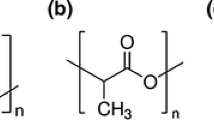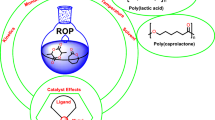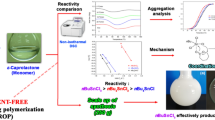Abstract
The anionic solution copolymerization of butadiene and styrene prepared by anionic living polymerization using an initiator composed of n-butyl lithium, and N,N,N′,N′-tetramethylethylenediamine as active center modifier was modeled as a tetrapolymerization. The kinetic model proposed considering that the reactivity of the active sites is different because of varying configurations cis, trans, vinyl, and styryl. From the reaction scheme expressions to rate of monomers consumption, microstructure and dyad formation were obtained. With the first-order Markov model, the expressions for the fraction of active sites and dyad distribution as a function of the conditional probabilities were obtained. Therefore, the model proposed is different to kinetic models previously reported, because it allows obtaining the parameters kinetic in order to know the distribution of the isomeric species presents in the copolymerization of butadiene and styrene, and the intrinsic reactivity of configurational active sites. The rate constants were determined by fitting to the conversion and dyad experimental data using the nonlinear least square method. The experimental data reported in the literature, monomer conversion and microstructure, in addition to dyad sequence distribution were correctly predicted.









Similar content being viewed by others
Abbreviations
- (C):
-
active sites cis
- FC :
-
cis isomer formation
- FT :
-
trans isomer formation
- FV :
-
vinyl isomer formation
- FS :
-
styrene isomer formation
- FCC :
-
dyad formation cis-cis
- FCT :
-
dyad formation cis-trans
- FCV :
-
dyad formation cis-vinyl
- FCSV :
-
dyad formation cis-styrene
- FTC :
-
dyad formation trans-cis
- FTT :
-
dyad formation trans-trans
- FTV :
-
dyad formation trans-vinyl
- FTS :
-
dyad formation trans-styrene
- FVC :
-
dyad formation vinyl-cis
- FVT :
-
dyad formation vinyl-trans
- FVV :
-
dyad formation vinyl-vinyl
- FVS :
-
dyad formation vinyl-styrene
- FSC :
-
dyad formation styrene-cis
- FST :
-
dyad formation styrene-trans
- FSV :
-
dyad formation styrene-vinyl
- FSS :
-
dyad formation styrene-styrene
- Fij :
-
total quantity of the ij dyad
- i:
-
active site that reacts with a butadiene molecule
- [I]:
-
initiator concentration
- j:
-
ending live isomer resulting from this reaction
- kij :
-
rate constant
- kiC, kiT, kiV, and kiS :
-
rate constants of the initiation
- M1 :
-
butadiene monomer
- M2 :
-
styrene monomer
- Р:
-
\( {\hbox{matrix }} = \left[ {\begin{array}{*{20}{c}} {{P_{CC}}} & {{P_{CT}}} & {{P_{CV}}} \\{{P_{TC}}} & {{P_{TT}}} & {{P_{TV}}} \\{{P_{VC}}} & {{P_{VT}}} & {{P_{VV}}} \\\end{array} } \right] \)
- Pij :
-
conditional probability of the active sites
- [Pc], [PT] [PV], [PS]:
-
concentration of active sites
- Pc1,0,0,0, PT 0,1,0,0, PV 0,0,1,0 :
-
active sites with one monomeric unit with the negative
- PS 0,0,0,1 :
-
charge located in the cis, trans and vinyl isomer respectively
- PX a,b,d,m :
-
living polymer with the negative charge located in the isomer X, (X = C, T, V or S) with a, b and d units of cis, trans, vinyl and styryl respectively
- val:
-
equality: rCT rTV rVC = rTC rCV rVT
- rij :
-
reactivity ratios
- Wi :
-
fraction of active sites
- W :
-
vector (Wc, WT, Wv, Ws)
- XCj, XTj, XVj, XSj :
-
butadiene conversion converted to the dyad Cj, Tj, Vj, Sj.
References
Kang J, Poulton J (1997) High trans-1,4 polybutadiene and catalyst and process for preparing crystalline high trans 1,4 polybutadiene. U.S. Pat. 5 596 053
Sandstorm PH, Roennau RB (2000) Method of preparing trans polybutadiene blend for use in tires. U.S. Pat. 6 024 146
Lynch T (2000) Synthesis of 1, 4-trans-polybutadiene using lanthanide organic acid salt catalyst. U.S. Pat. 6 184 168
Rivera M, Herrera-Nájera R, Ríos-Guerrero L (2006) Structure and properties of model polybutadienes and HIPS: effect of rubber microstructure on HIPS dynamic mechanical properties. J Elast Plast 38(2):133–146
Vargas MA, Chávez AE, Manero O, Herrera R (2005) Asphalt modified by partially hydrogenated SBS tri-block copolymers. Rubber Chem Tecnol 78(4):620–643
Morton M (1983) Anionic polymerization: Principles and practices. Academic, New York
Hsieh HL, Quirk RP (1996) Anionic polymerization: Principles and practical applications. Marcel Dekker, New York
Benvenuta-Tapia JJ, Tenorio-López JA, Herrera-Nájera R, Ríos-Guerrero L (2010) Synthesis and distribution of structural units–thermal property relationship of random and block butadiene-styrene copolymers with high trans 1, 4 units content produced using an initiator composed of alkyl aluminum, n-butyl lithium, and barium alkoxide. J Appl Polym Sci 116:3103–3110
Kelley DJ, Tobolsky AV (1959) Anionic copolymerization of isoprene and styrene. J Am Chem Soc 81:1597–1600
Johnson AF, Worsfold DJ (1965) Anionic copolymerization of styrene and butadiene. Makromol Chem 85:273–279
Zelinski RP (1961) Preparation of copolymers in the presence of an organolithium catalyst and a solvent mixture comprising a hydrocarbon and an ether, thioether or amine. US Patent 2 975 160
Hsieh LH, Wofford CF (1969) J Polym Sci A1(7):461
Halasa AF, Hsu WL (2002) Synthesis of high vinyl elastomers via mixed organolithium and sodium alkoxide in the presence of polar modifier. Polymer 43:7111
Halasa AF, Schulz DN, Tate DP, Mochel VD, Stone FG, West R (1980) Organolithium catalysis of olefin and diene polymerization. Adv Organomet Chem 18(55):97
Dotson NA, Galván R, Lawrence RL, Tirrell M (1996) Polymerization process modeling. VHC, New York
Bywater S, Firat Y, Black PE (1984) Microstructures of polybutadienes prepared by anionic polymerization in polar solvents. Ion-pair and solvent effects. J Polym Sci Polym Chem Ed 22(3):669–672
Halasa FA, Mochel VD, Fraenkel G (1981) Anionic polymerization. ACS Symp Ser 166(26):409–426
Chang CC, Halasa AF, Miller JW, Hsu L (1994) Modelling studies of the controlled anionic copolymerization of butadiene and styrene. Polym Int 33(2):151–159
Sato H, Takebayashi K, Tanaka Y (1987) Analysis of carbon-13NMR of polybutadiene by means of low molecular weight model compounds. Macromolecules 20:2418
Tanaka Y, Sato H, Ogawa M, Hatada K, Yoshio T (1974) Determination of sequence distribution in 1, 4-polybutadiene by 13C-NMR spectra. Polym Lett Ed 12(7):369–373
Benvenuta-Tapia JJ, Tenorio-López JA, Montiel C, Ríos-Guerrero L (2008) Kinetics of the Anionic Polymerization of Buta-1, 3-diene Considering Different Reactivities of the cis, trans and vinyl Structural Units. Macromol React Eng 22(5):436–451
Benvenuta-Tapia JJ, Tenorio-López JA, Herrera R (2008) Kinetics of the anionic polymerization of 1, 3-butadiene using an initiator composed of alkyl aluminium, n-butyllithium and barium alkoxide to produce high trans-1, 4-polybutadiene. Macromol React Eng 2(3):222–232
Benvenuta-Tapia JJ, Tenorio-López JA, Cuevas-Díaz MC (2009) Kinetics approximation considering different reactivities of the structural units formed by the anionic copolymerization of 1, 3-butadiene and styrene using Al/Li/Ba as initiator. Macromol React Eng 3(8):473–485
Price FP (1970) Markov chains and Monte Carlo calculations in polymer science. Marcel Dekker, New York
Boeing JL (1980) Chemical microstructure of polymer chains. Wiley, New York
Chang CC, Miller JW, Schorr GR (1990) Fundamental modeling in anionic polymerization processes. J Appl Polym Sci 39(11–12):2395–2417
Sutton TL, MacGregor JF (1977) The analysis and design of binary vapour-liquid equilibrium experiments. Part I: Parameter estimation and consistency tests. Can J Chem Eng 55(5):602–608
Valvassori A, Sartori G (1967) Adv Polym Sci 5:28
Chang CC, Halasa AF, Miller JW (1993) The reaction engineering of the anionic polymerization of isoprene. J Appl Polym Sci 47(9):1589–1599
Halasa AF, Hsu WL (2002) Synthesis of high vinyl elastomers via mixed organolithium and sodium alkoxide in the presence of polar modifierPolymer 43(5):7111–7118
Author information
Authors and Affiliations
Corresponding author
Rights and permissions
About this article
Cite this article
Tenorio-López, J.A., Benvenuta-Tapia, J.J., Castillo-Hernández, N.E. et al. Pseudokinetics for the copolymerization of butadiene and styrene produced using n-butyl lithium and N,N,N′,N′-tetramethylethylenediamine, considering different reactivities of the structural units. J Polym Res 18, 927–938 (2011). https://doi.org/10.1007/s10965-010-9490-5
Received:
Accepted:
Published:
Issue Date:
DOI: https://doi.org/10.1007/s10965-010-9490-5




